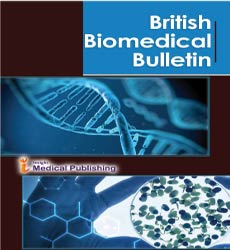ISSN : 2347-5447
British Biomedical Bulletin
Revolutionizing Medical Imaging: How Nanoparticles Improve Diagnostic Accuracy
Marco Leonardo*
Department of Pharmaceutical Sciences, University of Salamanca, Salamanca, Spain
- *Corresponding Author:
- Marco Leonardo
Department of Pharmaceutical Sciences, University of Salamanca, Salamanca,
Spain,
E-mail: leomarc@us.sp
Received date: May 15, 2024, Manuscript No. IPBBB-24-19403; Editor assigned date: May 20, 2024, PreQC No. IPBBB-24-19403 (PQ); Reviewed date: June 03, 2024, QC No. IPBBB-24-19403; Revised date: June 10, 2024, Manuscript No. IPBBB-24-19403 (R); Published date: June 17, 2024, DOI: 10.36648/2347-5447.12.2.46
Citation: Leonardo M (2024) Revolutionizing Medical Imaging: How Nanoparticles Improve Diagnostic Accuracy. Br Biomed Bull Vol:12 No.2: 46.
Description
Biomedical nanotechnology is a rapidly advancing field that integrates nanotechnology with biomedical sciences to develop innovative solutions for diagnosing, treating and preventing diseases. This interdisciplinary domain leverages the unique properties of nanomaterials to address complex medical challenges, offering potential in drug delivery, imaging, diagnostics and regenerative medicine. Nanotechnology involves the manipulation and control of matter at the nanoscale (1 to 100 nanometers). At this scale, materials exhibit unique physical, chemical and biological properties that differ from their bulk counterparts. These properties, such as increased surface area, quantum effects and enhanced reactivity, make nanomaterials highly suitable for biomedical applications. One of the most significant contributions of nanotechnology to medicine is in drug delivery. Nanoparticles can be engineered to deliver drugs directly to specific cells or tissues, improving the efficacy and reducing the side effects of treatments. Nanoparticles can be functionalized with ligands that bind to specific receptors on the surface of target cells, such as cancer cells. This allows for targeted drug delivery, minimizing damage to healthy tissues. Nano carriers can be designed to release their payload in response to specific triggers, such as pH changes, temperature variations, or enzymatic activity. This controlled release ensures that drugs are delivered at the optimal time and location. Many therapeutic agents have poor water solubility, limiting their effectiveness. Nanoparticles can improve the solubility and bioavailability of these drugs, enhancing their therapeutic potential.
Medical imaging
Nanotechnology has revolutionized medical imaging by providing contrast agents that enhance the visualization of biological structures and processes. Nanoparticles can improve the sensitivity and specificity of various imaging modalities, including: Superparamagnetic iron oxide nanoparticles are used as contrast agents to enhance MRI scans. These nanoparticles improve the contrast between healthy and diseased tissues, aiding in the early detection and diagnosis of conditions such as cancer. Gold nanoparticles are used as contrast agents in CT imaging due to their high X-ray attenuation properties. They provide better image contrast and resolution compared to traditional contrast agents. Quantum dots and other fluorescent nanoparticles are used in optical imaging techniques, such as fluorescence microscopy and near-infrared imaging. These nanoparticles provide bright and stable signals, enabling detailed visualization of cellular and molecular processes. Nanotechnology has led to the development of highly sensitive and rapid diagnostic tools for detecting diseases at an early stage. Nanoscale sensors and assays can detect low levels of biomarkers, pathogens and other disease indicators with high precision. Nanomaterial-based biosensors, such as those made from graphene or gold nanoparticles, can detect specific biomolecules in biological samples. These biosensors are used for point-of-care testing, enabling quick and accurate diagnosis of infections, cancers and metabolic disorders. Microfluidic devices integrated with nanotechnology, known as lab-on-a-chip, can perform multiple diagnostic tests on a single chip. These devices require minimal sample volumes and provide rapid results, making them ideal for remote and resource-limited settings. Nanotechnology is advancing the field of regenerative medicine by providing tools to engineer tissues and organs. Nanomaterials can mimic the natural extracellular matrix, promoting cell growth, differentiation and tissue regeneration. Nanofibrous scaffolds made from biodegradable polymers support the growth and organization of cells into functional tissues. These scaffolds are used to repair damaged tissues, such as skin, bone and cartilage. Nanoparticles can be used to deliver genes or growth factors to stem cells, enhancing their therapeutic potential. For example, magnetic nanoparticles can guide stem cells to the site of injury, improving tissue repair and regeneration.
Antimicrobial nanomaterials
Nanomaterials, such as silver nanoparticles and zinc oxide nanoparticles, exhibit strong antimicrobial properties. These nanomaterials can be incorporated into coatings, dressings, and medical devices to prevent infections and promote wound healing. Their unique mechanisms of action, such as generating reactive oxygen species and disrupting microbial cell membranes, make them effective against a broad range of pathogens, including antibiotic-resistant bacteria. Nanotechnology is preparing for personalized medicine, where treatments to an individual’s genetic profile and disease characteristics. Nanoparticles can deliver personalized drug regimens and nanoscale diagnostics can monitor treatment response in real time. Theranostics combines therapy and diagnostics in a single platform, enabling simultaneous disease detection and treatment. Nanoparticles designed for theranostics can diagnose, deliver therapeutic agents and monitor treatment efficacy, offering a comprehensive approach to disease management. Nanorobots, tiny machines designed to perform specific tasks at the nanoscale, hold promise for future medical applications. These nanorobots could perform precise surgeries, deliver drugs to hard-to-reach areas and remove disease-causing agents from the body. Biomedical nanotechnology is transforming healthcare by providing innovative solutions for diagnosis, treatment and prevention of diseases. Its unique capabilities to manipulate matter at the nanoscale open up new possibilities for personalized medicine, regenerative therapies and advanced diagnostics. As research and development continue to advance, biomedical nanotechnology of revolutionizing medicine and improving human health.
Open Access Journals
- Aquaculture & Veterinary Science
- Chemistry & Chemical Sciences
- Clinical Sciences
- Engineering
- General Science
- Genetics & Molecular Biology
- Health Care & Nursing
- Immunology & Microbiology
- Materials Science
- Mathematics & Physics
- Medical Sciences
- Neurology & Psychiatry
- Oncology & Cancer Science
- Pharmaceutical Sciences
